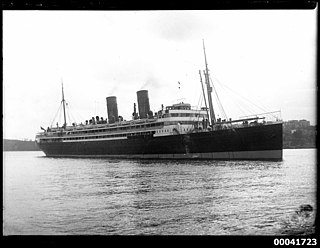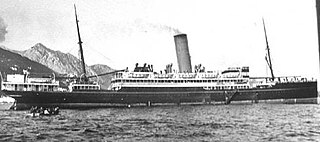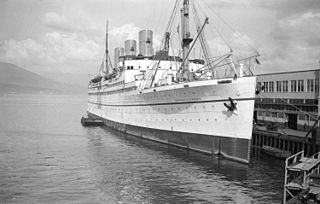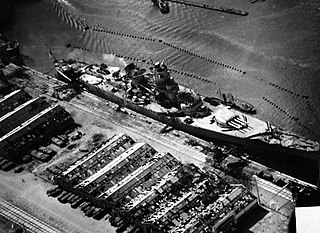
MS Wanganella was an Australian-registered ocean liner built by Harland and Wolff that entered service on the trans-Tasman route in 1933. Originally named Achimota, she was acquired by Huddart Parker after the original sale to Elder Dempster Lines fell through.

HMAS Anzac was a Parker-class destroyer leader that served in the Royal Navy and the Royal Australian Navy (RAN). Launched in early 1917 and commissioned into the Royal Navy, Anzac led the 14th Destroyer Flotilla of the Grand Fleet during the First World War. In 1919, she and five other destroyers were transferred to the RAN, with Anzac commissioning as an Australian warship in 1920. Except for three visits to New Guinea and one to the Solomon Islands, Anzac remained in southern and eastern Australian waters for her entire career. The destroyer was decommissioned in 1931, sold for scrapping four years later, stripped for parts, then towed outside Sydney Heads and sunk as a target ship in 1936.

RMS Niagara was a transpacific steam ocean liner, Royal Mail Ship and refrigerated cargo ship. She was launched in 1912 in Scotland and sunk in 1940 by a mine off the coast of New Zealand.

HMAS Canberra (I33/D33), named after the Australian capital city of Canberra, was a Royal Australian Navy (RAN) heavy cruiser of the Kent sub-class of County-class cruisers. Constructed in Scotland during the mid-1920s, the ship was commissioned in 1928, and spent the first part of her career primarily operating in Australian waters, with some deployments to the China Station.

Huddart Parker Ltd was an Australian shipping company trading in various forms between 1876 and 1961. It was one of the seven major coastal shippers in Australia at a time when shipping was the principal means of interstate and trans-Tasman transport. The company started in Geelong, but in 1890 shifted its offices to Melbourne. By 1910 Huddart Parker had grown to rank 24th of the top 100 companies in Australia by asset value. Several of the company's ships served in World War I and World War II. Huddart Parker ceased to be an independent company in 1961, when it was taken over by Bitumen and Oil Refineries Australia Limited.

SS Zealandia, nicknamed "Z", was an Australian cargo and passenger steamship. She served as a troopship in both World War I and World War II. Zealandia transported the Australian 8th Division. Her crew were the last Allied personnel to see HMAS Sydney, which was lost with all hands in 1941. Zealandia was sunk in the air raids on Darwin of 19 February 1942.

During World War II, surface raiders and submarines of the Axis powers, primarily Germany and Japan, conducted naval activities in various parts of the world, including the waters around New Zealand.

HMS Brilliant was a B-class destroyer built for the Royal Navy (RN) around 1930. Initially assigned to the Mediterranean Fleet, she was transferred to the Home Fleet in 1936. The ship then patrolled Spanish waters enforcing the arms blockade during the first year of the Spanish Civil War of 1936–39. She spent most of World War II on convoy escort duties in the English Channel, and the North Atlantic, based at Dover, Gibraltar, and Freetown, Sierra Leone. During the war, Brilliant never destroyed a submarine, but did sink a Vichy French minesweeper during Operation Torch. She also intercepted two German supply ships and rescued survivors of two troopships that had been torpedoed by submarines. The ship became a target ship at the end of the war and was scrapped in 1948.

HMNZS Monowai (F59) was a former Peninsular and Oriental Steam Navigation Company (P&O) merchant vessel. At the outbreak of World War II she became an armed merchant cruiser of the Royal New Zealand Navy (RNZN). She subsequently became HMS Monowai, a Landing Ship, Infantry and mostly operated as a troopship. In 1946 she returned to her old trade as a passenger ship.

The Cameron-class steamships were a class of UK cargo twin-screw steamships. They were designed for Clan Line and were also used by Scottish Shire Line and the Royal Navy.

RMS Empress of Canada was an ocean liner built in 1920 for the Canadian Pacific Steamships (CP) by Fairfield Shipbuilding & Engineering Company at Govan on the Clyde in Scotland. This ship—the first of three CP vessels to be named Empress of Canada—regularly traversed the trans-Pacific route between the west coast of Canada and the Asian waters until 1939.

Asama Maru was a Japanese ocean liner owned by Nippon Yusen Kaisha (NYK). The ship was built in 1927–1929 by Mitsubishi Shipbuilding & Engineering Co. at Nagasaki, Japan. The vessel was named after an important Shinto shrine.

The Naval Battle of Casablanca was a series of naval engagements fought between American ships covering the invasion of North Africa and Vichy French ships defending the neutrality of French Morocco in accordance with the Second Armistice at Compiègne during World War II.

SS Westralia was a 2,884 GRT cargo and passenger ship. She served as a troopship in the First World War and was later converted into a hulk. She was sunk in the air raids on Rabaul on 20 January 1942.

For other ships called SS Oronsay, see List of ships named Oronsay

TSS Wahine was a Union Steamship Company passenger steamship that was launched in Scotland in 1912 and wrecked in the Arafura Sea in 1951. She spent most of her career on inter-island ferry route between Wellington and Lyttelton, New Zealand. She was a minelayer in World War I, and a troop ship in World War I, World War II and the Korean War.
SS Tyndareus was a British steamship that was built in 1914–15 as a cargo liner for the Blue Funnel Line of the Ocean Steamship Company. Completed during the First World War, she served as a troop ship and was nearly sunk by a German naval mine, but without loss of life. Between the wars she operated commercially in the Pacific Ocean, before returning to military service in the Second World War. Her final civil role was to carry Islamic pilgrims from Indonesia to Mecca, before being scrapped in 1960.

















